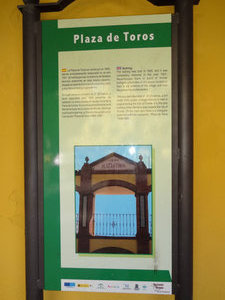PRIVATE BLOGGING ADVERTISING DISABLED
Published: July 18th 2013

 The Bullring in Cortes de la Frontera
The Bullring in Cortes de la Frontera
One of only two bullrings in the Serrania Ronda. The other is in Ronda and nowhere near as eye-catching - Just in case you're getting a little confused with the photos within the text, it's not you - it's me. Please be patient as I am still trying to learn how to construct one of these blog entries. I haven't been able to position the photos within the text as I would like, so the photos of the bullring continue into the text of our visit to Arcos de La Frontera. I'm sure you'll figure it out.
We decided to visit
Arcos de la Frontera, one of the most striking towns in the
Serrania Ronda and instead of taking the road most travelled we chose the scenic route through the mountains on a windy, partially damaged road which led to the bottom of a valley and then up the other side through
Cortes de la Frontera, which doesn't have a lot else going for it, and stumbled upon this bullring there right in the middle of the town. The colours were bold and it looked quite out of place, so we pulled into the perfect parking space, which for the mountains is so lucky and rare and decided to investigate. The main entrance was closed, but we found
an open gate around the side, where some young painters were hard at work and they didn't mind that we wanted to go inside to take some photos. So we did just that. The side entries into the arena are labelled for the bulls and the matadors and the seating is completely around the ring. The painters must have been hard at work for some time, as the paintwork looked stunning and fresh.
Most large towns and we believe all Spanish cities have a bullring somewhere, so we thought this was our best chance to see one from the inside without having a huge throng of people hovering close by. What a treat it was! Have a look!
Arcos de la FronteraThis town appears in all the guide books as one of the most impressive white villages, so we thought we'd better go and take a look with our cameras in hand. We were not disappointed, as the view from the plain to the ridge with the old town perched on top of the cliff is quite stunning. As with all of these towns, they began at the top of a ridge or cliff to give the townfolk the best possible
views of an approaching enemy. They usually had fortified city walls and of course, the required church, which was often partially destroyed during one of these sieges and then rebuilt. Keeping up with the history of who made what changes requires dedication to detail, which we have lost some interest in during our visits to so many villages, their old towns and churches - unless it's a name that's familiar to us or keeps re-appearing during our exploration in the south of Spain.
The narrow streets of white houses on both sides with their low doors and often shuttered windows are again a feature of this pueblo blanco, but we were nevertheless amazed that the tourist office is located near the end of one of these narrow streets rather than somewhere closer to where visitors might start their wandering.
Again we were surprised, although it just shows that we are foreigners, that many of the shops, even gift, souvenir and food shops close during the middle of the day, while the tourists are visiting. We did find one shop with a fluent English-speaking shop owner, who keeps his doors open all day. He said that it was necessary to be open
during these difficult (economic) times and fully understood that if he was open he might make the sales the others can't if they are closed. Yes, he studied elsewhere and has clearly lived outside .
So have a look at what we saw and see if you could be as pleased as we were that we made the journey.
By the way "de la Frontera" means by the border and this refers to the border between the Moors and the Spaniards, so the name appears in a lot of village names and makes it easy to work out what the border once was.
PRIVATE BLOGGING ADVERTISING DISABLED
Tot: 0.105s; Tpl: 0.012s; cc: 10; qc: 49; dbt: 0.0446s; 1; m:domysql w:travelblog (10.17.0.13); sld: 1;
; mem: 1.2mb

 The Bullring in Cortes de la Frontera
The Bullring in Cortes de la Frontera










